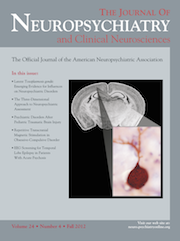Cotard’s Syndrome in Post-Surgical Patients
To the Editor: In 1882, Jules Cotard, a French psychiatrist, while working with melancholic patients, described a nihilistic syndrome, characterized by peculiar beliefs that they were dead, their internal organs were nonexistent, or they were immortal.1 It is now clear that this relatively uncommon syndrome typically develops in middle-aged or elderly depressed individuals and affects both genders equally.2 Rarely, it has been described in young adults with bipolar depression,3 in schizophrenia,4 or organic conditions like senile dementia, general paresis,2 delirium,5 brain injury,6 and seizures.7 We report three cases of Cotard’s syndrome developing in the post-surgical phase after abdominal surgery, in the absence of previous neuropsychiatric illness.
Case Reports
“Mr. A,” a 57-year-old executive, underwent laparoscopic cholecystectomy for cholelithiasis in 2009. On the 7th post-operative day, he noticed a slight purulent discharge along the suture line and erroneously concluded that his intestines were rotting away. He insisted on further investigations despite doctors’ reassurances and held on to this belief well after the stitch line had healed. On psychiatric evaluation, he was oriented, appeared depressed, and was convinced that he was going to die because his intestines were decomposing. On further inquiry, although he denied previous psychiatric episode, he admitted being worried about his unemployment for the past 4 months. His investigations were normal except for mildly elevated liver enzymes. He was diagnosed as suffering from a severe depressive episode with psychotic symptoms. His Hamilton Rating Scale for Depression (Ham-D) score was 21, which declined to 4 on treatment with sertraline 100 mg/day after 4 weeks. His particular nihilistic beliefs lasted nearly 4 weeks.
“Mr. B,” a 58-year-old businessman successfully underwent hemicolectomy for diverticulitis in 2009. Shortly after surgery, he experienced an increase in bowel frequency and poor appetite, and became convinced that his intestines were decomposing. This belief persisted for 6 months despite lack of objective evidence of infection and repeated assurances from the surgeon. Finally, he was referred to psychiatric services for progressively increasing sadness and withdrawn behavior. He was hypertensive, well-controlled on amlodipine 10 mg/day, and he denied any previous psychiatric episode. On examination, he displayed psychomotor retardation and expressed nihilistic delusions. He was diagnosed with severe depression with psychotic symptoms and was prescribed sertraline 100 mg/day and clonazepam 0.5 mg/day. There was marked improvement and his Ham-D score decreased from 28 at baseline to 8 after 4 weeks of treatment.
“Mr. C,” a 62-year-old retired carpenter, presented in 2010 with irrational beliefs that his insides had rotten away, his heart had stopped functioning, and he had been dead, for the last 3½ years. He had been suffering from chronic obstructive pulmonary disease (COPD) for the last 6 years. In 2005, he had developed a right-sided inguinal hernia, for which inguinal herniorrhaphy was performed; however, there was a recurrence of hernia within 18 months of surgery, possibly due to an increase in intra-abdominal pressure secondary to acute exacerbations of COPD. Since then, Mr. C would often say that his intestines were rotting and coming out of his body in the form of a hernia. This abnormal belief persisted for the next 6 months and subsided after successful hernioplasty in 2007. Within a year the hernia reappeared because of another exacerbation of COPD, followed closely by resurgence of similar nihilistic beliefs. Repeat hernioplasty in 2009 resulted in lasting surgical remission, although without any commensurate decline in the nihilistic beliefs. Also, Mr. C had developed low mood, restlessness, diminished appetite, and lack of sleep, a year before the current psychiatric consultation.
Physical examination revealed bronchial breath sounds and crepts over bilateral lung fields. On mental status examination, Mr. C was oriented, agitated, and expressed a firm belief that he was dead, while, paradoxically, having suicidal ideations, as well. Hematological and biochemical parameters, including liver and kidney functions, electrolytes, and arterial blood gases, were within normal limits. CT scan of head was unremarkable. He was diagnosed as suffering from delusional disorder, somatic type, with secondary depression; his Ham-D score was 38. He was prescribed mirtazapine 30 mg/day, risperidone 3 mg/day, trihexyphenidyl 4 mg/day, and clonazepam 1 mg/day, which resulted in substantial improvement in depressive symptoms in 4 weeks’ time, when his Ham-D score declined to 11. His nihilistic beliefs, although less intense, persisted in the form of preoccupation with functioning of his internal organs.
Discussion
Although rare, Cotard's syndrome is readily recognized as a psychiatric condition because of its strikingly abnormal thought content. In our patients, however, this was not so, because their nihilistic beliefs developed in the wake of abdominal surgery and appeared credible to their caregivers and surgeons, thus delaying definitive psychiatric management.
To our knowledge, there is only one published case report of Cotard’s delusion developing after surgery.8 In view of the strong temporal relationship evident in our cases, we hypothesize that abdominal surgery could be a possible independent risk factor for development of Cotard’s syndrome in predisposed individuals, although further psychopathological studies are required in patients undergoing abdominal surgery to achieve a better understanding of this phenomenon. Improved surgical and psychiatric outcomes are likely to result from timely recognition of Cotard’s syndrome in the postoperative period.
1 : Du delire des negations. Arch Neurol 1882; 4:152–170, 282–296Google Scholar
2 : Cotard’s syndrome: analysis of 100 cases. Acta Psychiatr Scand 1995; 91:185–188Crossref, Medline, Google Scholar
3 : Cotard’s syndrome in a young male bipolar patient. J Neuropsychiatry Clin Neurosci 2000; 12:119–120Link, Google Scholar
4 : Cotard’s syndrome in a patient with coexistent Capgras’ syndrome, syndrome of subjective doubles, and palinopsia. J Clin Psychiatry 1986; 47:605–606Medline, Google Scholar
5 : Cotard’s syndrome and the psychiatric manifestations of typhoid fever. Am J Psychiatry 1981; 138:1377–1378Crossref, Medline, Google Scholar
6 : Cotard delusion after brain injury. Psychol Med 1992; 22:799–804Crossref, Medline, Google Scholar
7 : Sequential Cotard and Capgras delusions. Br J Clin Psychol 1993; 32:345–349Crossref, Medline, Google Scholar
8 : Un caso di syndrome di Cotard. Riv Sper Fren 1956; 80:491–514Medline, Google Scholar



